Glute exercises—barbell hip thrusts, wide-stance squats, and booty blaster machines—are often considered the bailiwick of women.
Just because many women are wont to train their derrieres, though, doesn’t mean men shouldn’t. Strong glutes are a boon to your performance in just about every way, including helping you lift heavier weights, run faster, jump higher, and stay injury-free.
And although defined glutes may not be the linchpin of an attractive male physique, having a small, flat, shapeless butt will cross up the aesthetics of your lower body. In other words, while you don’t need to put too much time into training your glutes, you also don’t want them to be glaring weakness, either.
The simplest and most effective way to build strong, attractive glutes is to do the right butt exercises. Unfortunately, many of the glute exercises and workouts you’ll find online don’t cut the mustard—things like bodyweight glute bridges, wall sits, and running stairs, which are often advertised as “the best butt toning exercises.”
While these butt exercises are better than nothing, they aren’t the most efficient way to build your behind.
In this article, you’ll learn the best butt exercises you can do to maximize glute size and strength, so you can look and perform at your best.
Table of Contents
+
The 10 Best Butt Exercises
1. Barbell Back Squat
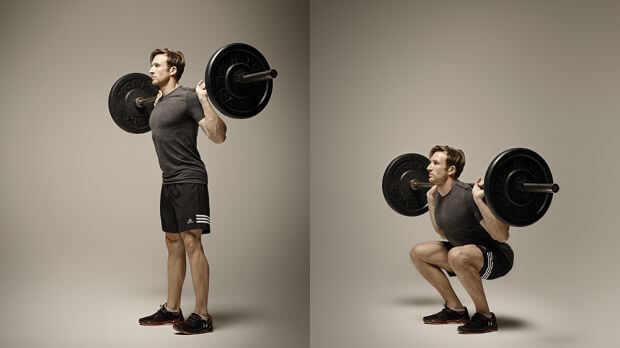
Research shows the barbell back squat is even more effective at training the glutes than so-called glute exercises like the hip thrust. To maximize the amount of work your glutes do while squatting, use the low-bar position and squat to parallel or deeper (the point where your knees are roughly at the height of your hip crease).
Some research also shows that using a wider-than-shoulder-width stance when you squat might better activate the glutes than using a normal or narrow stance. Thus, if your main goal is to build your glutes, you may want to try squatting with your feet a few inches wider than usual. Don’t squat so wide that it’s difficult for your knees to travel in the same direction as your toes, as this can increase your risk of injury.
How to: Position a barbell in a squat rack at about the height of your breast bone. Step under the bar, pinch your shoulder blades together, and rest the bar directly above the bony ridges on the bottom of your shoulder blades. Lift the bar out of the rack, take one or two steps backward, and place your feet a little wider than shoulder-width apart with your toes pointing slightly outward. Sit down and remember to keep your back straight and push your knees out in the same direction as your toes throughout each rep. Stand up and return to the starting position.
2. Barbell Front Squat
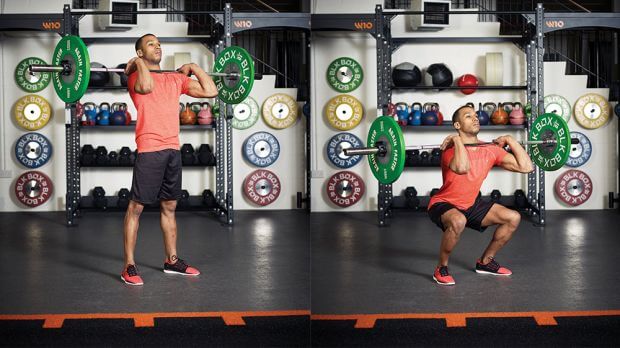
Most people think of the front squat as a quad exercise, but studies show it’s one of the best butt exercises you can do, too. What’s more, research also shows that the front squat places considerably less compressive forces on your knees and lower back, which make it a particularly good alternative to back squats for people who have knee or back issues.
How to: Position a barbell in a squat rack at about the height of your nipples. Grab the bar with a shoulder-width grip and your palms facing away from you. Step closer to the bar so that it presses against the front of your shoulders and push your elbows up and out in front of the bar.
With the bar resting on the front of your shoulders and held in place by your hands, lift it out of the rack, take one or two steps backward, and position your feet a little wider than shoulder-width apart with your toes pointing slightly outward. Sit down and remember to keep your back straight, elbows up, and knees traveling the same direction as your toes throughout each rep. Stand up and return to the starting position.
3. Deadlift
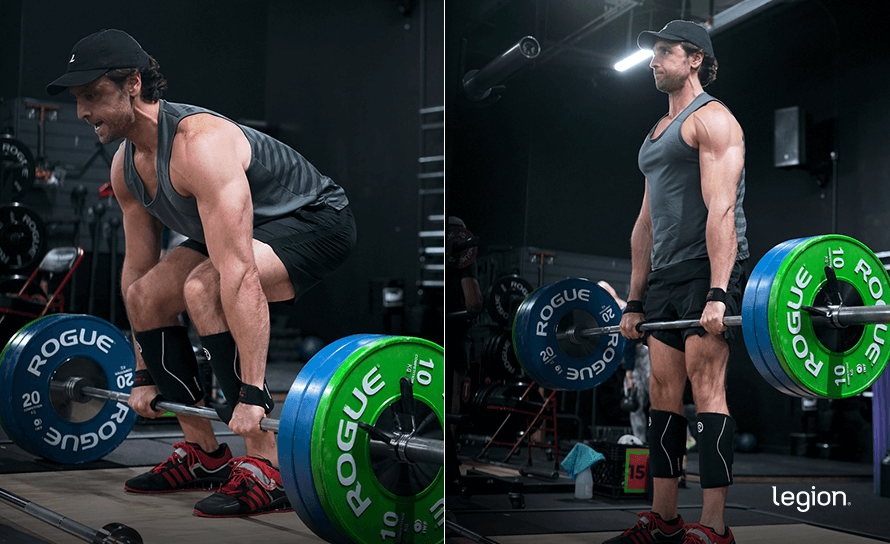
The deadlift is hands down the best exercise for training your entire posterior chain (the muscles on the back side of your body, including your glutes). It also allows you to use some of the heaviest weights in any of your workouts, which means it’s ideal for gaining strength and muscle.
Tip: If you can’t do conventional deadlifts for any reason, try sumo deadlifts or trap-bar deadlifts instead. They both train your glutes about a well as the conventional deadlift, but some people find them more comfortable.
How to: Position your feet so they’re slightly narrower than shoulder-width apart with your toes pointed slightly out. Move a loaded barbell over your midfoot so it’s about an inch from your shins. Take a deep breath into your belly, then place your hands on the bar just outside your shins. Flatten your back and drive your body upward and slightly back by pushing through your heels until you’re standing up straight. Reverse the movement and return to the starting position.
4. Romanian Deadlift (RDL)
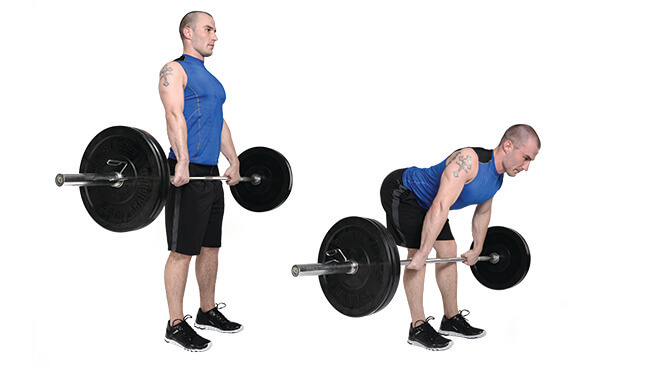
The Romanian deadlift (RDL) trains the posterior chain in a very similar way to the conventional deadlift. However, because of the difference in form, you put a larger emphasis on your hamstrings and glutes rather than your back. It’s also considerably less fatiguing than the conventional deadlift, which means you can do it more often without wearing yourself to a frazzle.
How to: Stand up straight holding a loaded barbell with a shoulder-width, overhand grip (palms facing toward your body). Lower the weights toward the floor while keeping your legs mostly straight, allowing your butt to move backward as you descend. Once you feel a stretch in your hamstrings, bend your knees slightly more, and continue lowering the weights until your lower back begins to round—just below the knees for most people, and about mid-shin for those who are particularly flexible. Reverse the movement and return to the starting position.
5. Bulgarian Split Squat
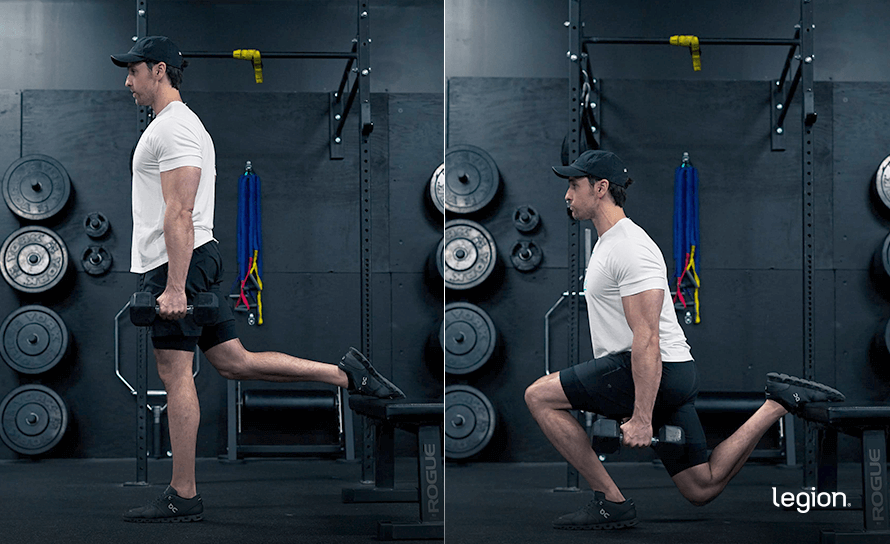
Research shows that the dumbbell Bulgarian split squat is a great exercise for training the glutes. Because the Bulgarian split squat trains just one leg at a time, it’s particularly useful for identifying and evening out any muscle or strength imbalances you might have, too.
How to: While holding a dumbbell in each hand, stand about two-to-three feet in front of a bench. With your right foot (and heel in particular) firmly planted, place the top of your left foot on the bench behind you. Look at a spot on the floor six-to-ten feet in front of you and lower your butt toward the floor by bending at your right knee. Keep lowering yourself until your right thigh is roughly parallel with the floor. Stand up and return to the starting position.
6. Hip thrust

Because of the way the barbell is positioned during hip thrusts, your glutes are forced to work hard throughout the entire range of motion, which isn’t the case for squats, deadlifts, or most other glute exercises. Thus, although the hip thrust may not be the be-all and end-all of glute exercises, it’s still worth doing.
How to: Sit on the floor with your back resting against a bench. The bench should be perpendicular to your body and your shoulders should be resting on the middle of the bench. Roll a barbell over your thighs so that it sits in your hip crease (use a bar pad to protect your hip bones from bruising and make the exercise more comfortable).
Plant your feet on the floor about shoulder-width apart with your toes pointing slightly outward so that your knees are bent to about 90 degrees. Push the bar upward with your hips by pressing through your heels until your upper body and thighs are parallel to the floor and your shins are vertical. Reverse the movement and return to the starting position.
7. Good Morning
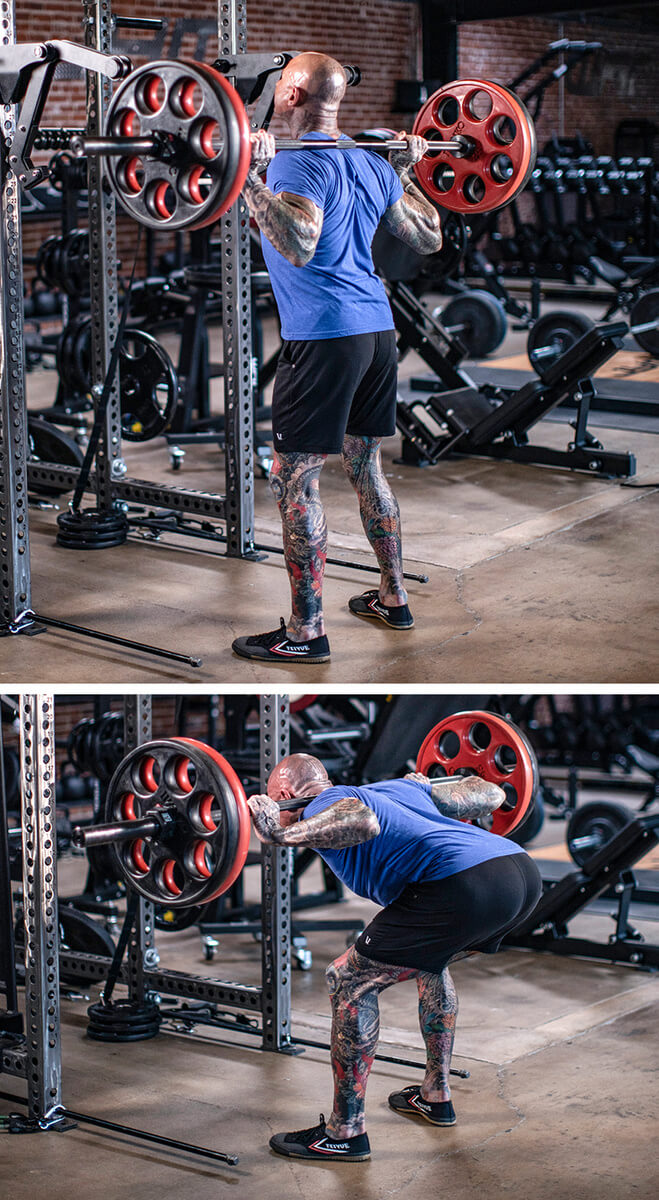
The good morning trains the glutes, hamstrings, and lower back in a similar way to the RDL. However, because of the change in form and execution, you put slightly more emphasis on the semitendinosus muscle of the hamstrings, and less emphasis on the biceps femoris. For those of you who skipped anatomy class, all this means is that the good morning emphasizes a slightly different portion of your hamstring muscles, ensuring you develop a proportional, strong posterior chain.
How to: Position a barbell in a squat rack at about the height of your nipples. Step under the bar, pinch your shoulder blades together, and rest the bar directly above the bony ridges on the bottom of your shoulder blades. Lift the bar out of the rack, take one or two steps backward, and place your feet shoulder-width apart with your toes pointing slightly outward.
While keeping your back flat, bend forward at the hips, allowing your butt to move backwards as you descend. Once you feel a stretch in your hamstrings, bend your knees slightly more, and continue lowering the weights until your lower back begins to round. Then simultaneously drive your hips forward to return to the starting position.
8. Dumbbell or Barbell Lunge

Research shows that lunges are one of the best exercises you can do to train your entire lower body, including your glutes. The lunge also requires greater balance and coordination than most other glute exercises, which means it also trains smaller, stabilizer muscles throughout your entire body.
How to: Holding a dumbbell in each hand, stand up straight with both feet about shoulder-width apart. Take a long step forward with your right foot—about two-to-three feet. With most of your weight on your front foot, kneel down until your left knee touches the floor. Then, reverse the motion by pushing off the floor with your front foot and leaning slightly backward, allowing your legs to straighten. Once you’re standing, bring your right foot back to the starting position.
9. Step-up
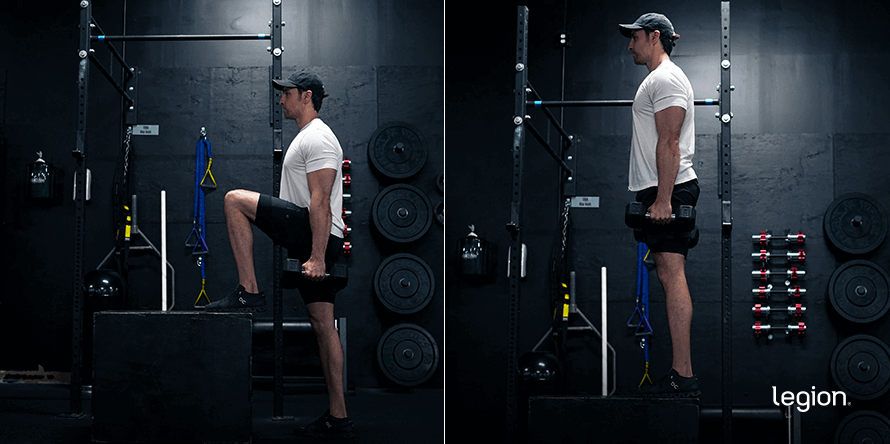
Research shows that the step-up is one of the single best exercises for activating the glutes, which indicates it’s also an effective exercise for building and strengthening your booty. The downside is that you generally can’t use as much weight with the step-up as you can with other exercises like the squat, deadlift, or hip thrust, which is why it’s best to use this as an “accessory” exercise toward the end of your workouts.
How to: Holding a dumbbell in each hand, place your right foot on a box, bench, or other surface about knee-height off the floor. Keeping your weight on your right foot, fully straighten your right leg. Then, lower your left foot toward the floor, and return to the starting position.
10. Kettlebell Swing
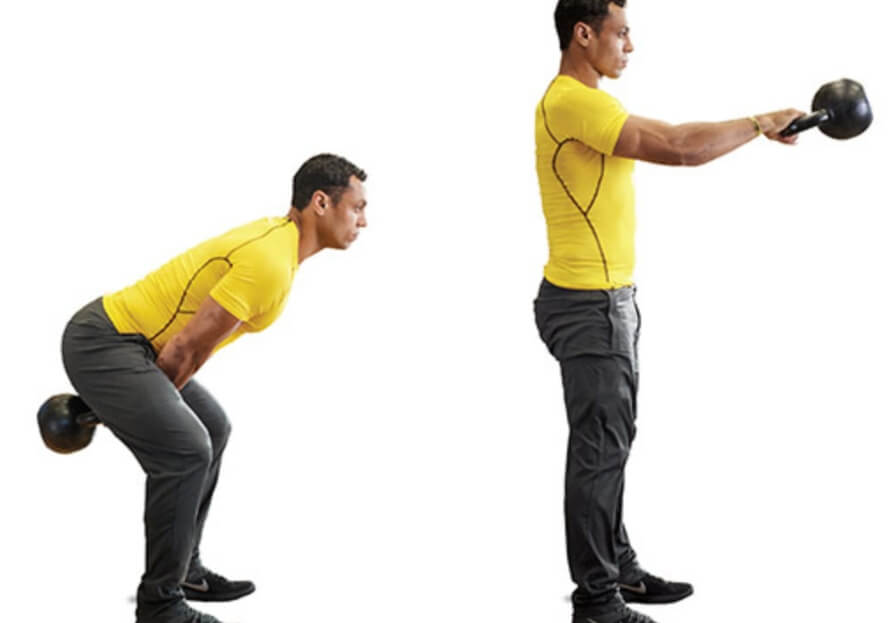
The kettlebell swing trains all the muscles of the posterior chain, and builds explosive strength that will improve your athletic performance across the board. It also challenges your cardiovascular system, making it one of the few effective ways to combine cardio and strength training in a single exercise.
How to: Place a kettlebell on the floor about a foot in front of you and stand with your feet just outside of shoulder-width apart. Bend over at the hips and grab the kettlebell handle with both hands and your palms facing toward you.
Brace your core and lift the kettlebell about a foot off the floor into roughly a half-deadlift position. Explosively drive through your hips to swing the kettlebell upward in an arc in front of you until it reaches about chest height. Your arms should control the path of the kettlebell, but shouldn’t pull or push it in any direction (they’re just along for the ride, basically). Once the kettlebell reaches the top of the swing, allow it to drop down between your legs to the starting position before immediately starting the next rep.
Scientific References +
- Lake, J. P., & Lauder, M. A. (2012). Kettlebell swing training improves maximal and explosive strength. Journal of Strength and Conditioning Research, 26(8), 2228–2233. https://doi.org/10.1519/JSC.0b013e31825c2c9b
- Gelder, L. H. Van, Hoogenboom, B. J., Alonzo, B., Briggs, D., & Hatzel, B. (n.d.). EMG Analysis and Sagittal Plane Kinematics of the Two-Handed and Single-Handed Kettlebell Swing: A Descriptive Study - PubMed. Retrieved May 19, 2021, from https://pubmed.ncbi.nlm.nih.gov/26618061/
- Alkjær, T., Wieland, M. R., Andersen, M. S., Simonsen, E. B., & Rasmussen, J. (2012). Computational modeling of a forward lunge: Towards a better understanding of the function of the cruciate ligaments. Journal of Anatomy, 221(6), 590–597. https://doi.org/10.1111/j.1469-7580.2012.01569.x
- Krause Neto, W., Soares, E. G., Vieira, T. L., Aguiar, R., Chola, T. A., Sampaio, V. de L., & Gama, E. F. (2020). Gluteus maximus activation during common strength and hypertrophy exercises: A systematic review. In Journal of Sports Science and Medicine (Vol. 19, Issue 1, pp. 195–203). Journal of Sport Science and Medicine. http://www.jssm.org
- Martín-Fuentes, I., Oliva-Lozano, J. M., & Muyor, J. M. (2020). Electromyographic activity in deadlift exercise and its variants. A systematic review. PLoS ONE, 15(2), e0229507. https://doi.org/10.1371/journal.pone.0229507
- Contreras, B., Cronin, J., & Schoenfeld, B. (2011). Barbell hip thrust. Strength and Conditioning Journal, 33(5), 58–61. https://doi.org/10.1519/SSC.0b013e31822fa09d
- Jones, M. T., Ambegaonkar, J. P., Nindl, B. C., Smith, J. A., & Headley, S. A. (2012). Effects of unilateral and bilateral lower-body heavy resistance exercise on muscle activity and testosterone responses. Journal of Strength and Conditioning Research, 26(4), 1094–1100. https://doi.org/10.1519/JSC.0b013e318248ab3b
- ESCAMILLA, R. F., FRANCISCO, A. C., KAYES, A. V., SPEER, K. P., & MOORMAN, C. T. (2002). An electromyographic analysis of sumo and conventional style deadlifts. Medicine & Science in Sports & Exercise, 34(4), 682–688. https://doi.org/10.1097/00005768-200204000-00019
- Gullett, J. C., Tillman, M. D., Gutierrez, G. M., & Chow, J. W. (2009). A biomechanical comparison of back and front squats in healthy trained individuals. Journal of Strength and Conditioning Research, 23(1), 284–292. https://doi.org/10.1519/JSC.0b013e31818546bb
- Neto, W. K., Soares, E. G., Vieira, T. L., & Aguiar, R. (n.d.). (PDF) Gluteus Maximus Activation during Common Strength and Hypertrophy Exercises: A Systematic Review. Retrieved May 19, 2021, from https://www.researchgate.net/publication/339302672_Gluteus_Maximus_Activation_during_Common_Strength_and_Hypertrophy_Exercises_A_Systematic_Review
- Wilczyński, B., Zorena, K., & Ślęzak, D. (2020). Dynamic knee valgus in single-leg movement tasks. Potentially modifiable factors and exercise training options. a literature review. In International Journal of Environmental Research and Public Health (Vol. 17, Issue 21, pp. 1–17). MDPI AG. https://doi.org/10.3390/ijerph17218208
- McCaw, S. T., & Melrose, D. R. (1999). Stance width and bar load effects on leg muscle activity during the parallel squat. Medicine and Science in Sports and Exercise, 31(3), 428–436. https://doi.org/10.1097/00005768-199903000-00012
- Paoli, A., Marcolin, G., & Petrone, N. (2009). The effect of stance width on the electromyographical activity of eight superficial thigh muscles during back squat with different bar loads. Journal of Strength and Conditioning Research, 23(1), 246–250. https://doi.org/10.1519/JSC.0b013e3181876811
- Glassbrook, D. J., Helms, E. R., Brown, S. R., & Storey, A. G. (2017). A Review of the Biomechanical Differences between the High-Bar and Low-Bar Back-Squat. In Journal of Strength and Conditioning Research (Vol. 31, Issue 9, pp. 2618–2634). NSCA National Strength and Conditioning Association. https://doi.org/10.1519/JSC.0000000000002007
- Barbalho, M., Coswig, V., Souza, D., Serrão, J. C., Hebling Campos, M., & Gentil, P. (2020). Back Squat vsHip Thrust Resistance-training Programs in Well-trained Women. International Journal of Sports Medicine, 41(5), 306–310. https://doi.org/10.1055/a-1082-1126
- Buckthorpe, M., Stride, M., & Villa, F. Della. (2019). ASSESSING AND TREATING GLUTEUS MAXIMUS WEAKNESS – A CLINICAL COMMENTARY. International Journal of Sports Physical Therapy, 14(4), 655–669. https://doi.org/10.26603/ijspt20190655
- Millar, N. A., Colenso-Semple, L. M., Lockie, R. G., Marttinen, R. H. J., & Galpin, A. J. (2020). In-season hip thrust vs. Back squat training in female high school soccer players. International Journal of Exercise Science, 13(4), 49–61. http://www.intjexersci.com
- Morin, J. B., Gimenez, P., Edouard, P., Arnal, P., Jiménez-Reyes, P., Samozino, P., Brughelli, M., & Mendiguchia, J. (2015). Sprint acceleration mechanics: The major role of hamstrings in horizontal force production. Frontiers in Physiology, 6(DEC), 404. https://doi.org/10.3389/fphys.2015.00404










